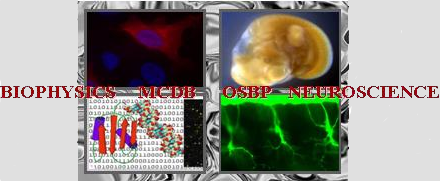Poster abstracts
Poster number 24 submitted by Lily Schumacher
Characterizing force transfer across Arabidopsis LINC complexes
Lily Schumacher (Biophysics Graduate Program), Norman R. Groves (Department of Molecular Genetics, The Ohio State University), Daniel E. Conway (Department of Molecular Genetics, The Ohio State University), Iris Meier (Department of Biomedical Engineering, The Ohio State University)
Abstract:
Nuclear movement and positioning are associated with development and environmental responses in animals, fungi, and plants. Nuclear movement can be mediated by Linker of Nucleoskeleton and Cytoskeleton (LINC) complexes, which consist of inner nuclear membrane Sad1/UNC-84 (SUN) proteins and outer nuclear membrane Klarsicht/ANC-1/Syne Homology (KASH) proteins. KASH proteins interact with SUN proteins via a 9-30 amino acid C-terminal KASH domain. In C. elegans, SUN-KASH disulfide bonds and tail lengths are differentially required for the forces from nuclear movement and nuclear positioning. In animals, a genetically encoded fluorescence resonance energy transfer (FRET)-based KASH tension biosensor was developed to measure forces across an animal LINC complex in response to actomyosin contractility and cell elongation. Animal and plant KASH domains differ in size and amino acid composition. In plants, the structural and force requirements of KASH domains have not yet been investigated. In Arabidopsis, the KASH protein SINE1 plays a role in the closure of stomatal pores during drought stress. The KASH protein WIP1 is required for nuclear movement, while loss of WIP1 leads to a circularization of nuclei in roots and disordered nuclear migration in pollen tubes.
To test whether specific KASH domains are required for KASH functions, we have created chimeric Arabidopsis KASH proteins with swapped KASH domains and placed them under native promoters in sine1 and wip1/2/3 mutants. We have shown that the C-terminal KASH domain is distinctive to the cellular function of each plant KASH protein. To query whether force transmission through the LINC complex is involved in this process, we have generated a SINE1 FRET-based tension sensor (TS-SINE1) and have validated that TS-SINE1 is located at the nuclear envelope and able to undergo FRET in a transient system. We will characterize the force being transferred across a plant LINC complex during osmotic stress and actin depolymerization, and will place the sensor in transgenic sine1 plants to measure native levels of force during different cellular conditions. Use of KASH biosensors in plants will establish quantitative, dimensionally relevant biophysical measurements of plant nuclear mechanotransduction.
Keywords: LINC Complex, FRET, Plant Biology
